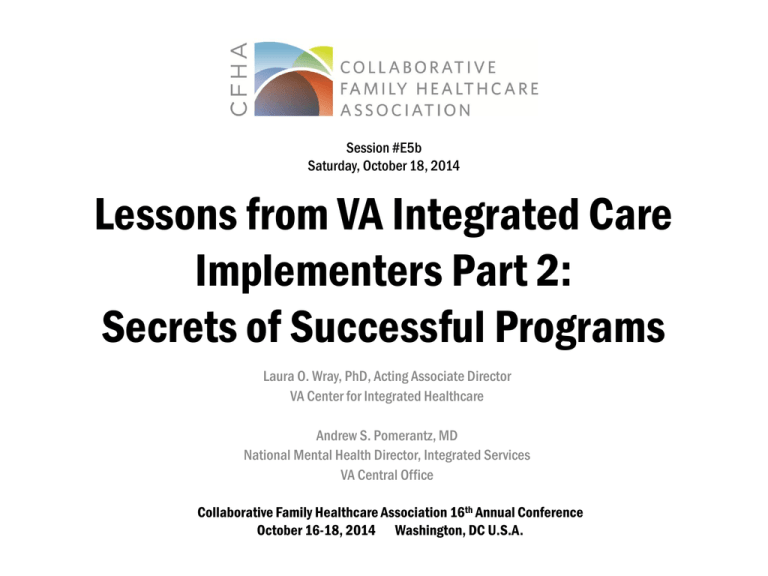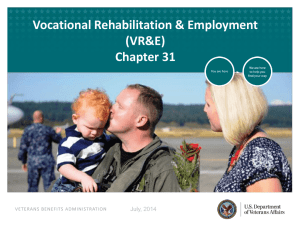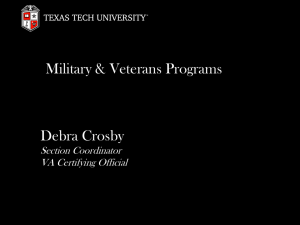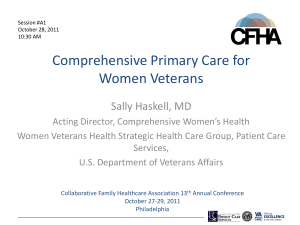E5b - Collaborative Family Healthcare Association
advertisement

Session #E5b Saturday, October 18, 2014 Lessons from VA Integrated Care Implementers Part 2: Secrets of Successful Programs Laura O. Wray, PhD, Acting Associate Director VA Center for Integrated Healthcare Andrew S. Pomerantz, MD National Mental Health Director, Integrated Services VA Central Office Collaborative Family Healthcare Association 16th Annual Conference October 16-18, 2014 Washington, DC U.S.A. Faculty Disclosure • We currently have or have had the following relevant financial relationships (in any amount) during the past 12 months: – We are both full-time employees of the US Department of Veterans Affairs • The views expressed in this presentation are those of the authors and do not necessarily reflect the position or policy of the Department of Veterans Affairs or the United States government. Acknowledgements: – Mona Ritchie, MSW, Primary Qualitative Analyst – All the members of the Team Summit planning committee – All of the attendees, the highly successful teams who are making integration happen in VA primary care Learning Objectives At the conclusion of this session, the participant will be able to: • Describe common challenges faced when attempting to integrate mental health services into primary care • Describe critical factors reported by successful programs • Understand how lessons learned at a variety of VA sites during program implementation can be applied to other health care systems • List implementation strategies that may be helpful at his/her own site. Bibliography / Reference 1. Beehler, G. P., & Wray, L. O. (2012). Behavioral health providers’ perspectives of delivering behavioral health services in primary care: a qualitative analysis. BMC Health Services Research, 12(1), 337. doi:10.1186/1472-6963-12-337 2. Kearney, LK. Post, EP, Pomerantz AS & Zeiss, AM (2014). Applying the Interprofessional Patient Aligned Care Team in the Department of Veterans Affairs: Transforming Primary Care. American Psychologist 69 (4). 399-408. 3. Pomerantz, AS, Kearney, LK, Wray, LO, Post EP & McCarthy, JF (2014). Mental health services in the medical home in the Department of Veterans Affairs: Factors for successful integration. Psychological Services; 11(3). 243-253. 4. Pomerantz, AS & Sayers, SL (2010). Primary care-mental health integration in healthcare in the Department of Veterans Affairs. Families, Systems & Health, 28(2). 78-82. 5. Wray, LO, Szymanski, BR, Kearney, LK et al. (2012) Implementation of primary caremental iealth Integration services in the Veterans Health Administration: Program activity and associations with engagement in specialty mental health services. Journal of clinical psychology in medical settings 19(1). 105-116. Learning Assessment • A learning assessment is required for CE credit. • A question and answer period will be conducted at the end of this presentation. But what does VA have to do with anything outside of VA? • VA is a single payer capitated healthcare system • VA is an Accountable Care Organization • Everyone says if we have both of those things we will have integrated care • But it is a struggle, even when we get the system we want Key Points from Part 1 • Presentation at CFHA 2013 on common challenges to implementation: How Innovators Manage Real World Push-Back: Lessons from VA Integrated Care Implementers Patient Aligned Care Team 8 Principles of Integrated Care in VA • Open or advanced access (temporal and spatial integration) in VA medical homes [PACT] • Problem-focused assessment and treatment: tend to what the Veteran wants tended to • On-site clinicians in primary care: Consultation, collaboration, assessment • Stepped care • Measurement-based care • Care management • Referral management when needed Primary Care-Mental Health Integration [PC-MHI] in VA • Two components: • Care management (CM) • Co-located collaborative care (CCC) • Blended programs link these complementary components as appropriate • Focus primarily on common mental health conditions: • Depressive and anxiety disorders • Alcohol misuse and abuse • PTSD screening/assessment • Health Behavior Coordinators implement health psychology programs along with Health Promotion/Disease Prevention Program Managers 10 Implementation Status • 2006 Initial RFP • 2008 Uniform Mental Health Service Handbook • VA Medical Centers and very large Community Based Outpatient Clinics (CBOCs) must have CCC and CM on a full-time basis • Large CBOCs’ hours and days of availability of integrated care services can vary depending upon the clinical needs of the patient population • Where are we in 2014? Rogers’ Diffusion of Innovation Where are we for PCMHI implementation?? (Rogers, 1962) Charting the Course: Integrating PACT Mental/Behavioral Health and Patient Centered Care • Goal: Identify essential ingredients of high performing integrated teams. – Discover how they overcame barriers to integration – Learn their perceptions of what makes them successful now – Garner advice from these expert teams on how to assist others in the field • Methods: – – – – Competitive selection process for team attendees Broad call for proposals Invitation to apply preferred some teams known to be successful Three independent, blind ratings of applications by planning committee members – Good agreement across ratings despite ideosyncratic scoring methods Charting the Course: Integrating PACT Mental/Behavioral Health and Patient Centered Care • Methods (continued): – Gathered 11 of the 12 highest ranked teams on January 15-16, 2014 – Meeting facilitators fostered a spirit of collegial exchange – Structured exercises and group discussions used to gather team input – Captured output of all exercises and discussions • Group Note Sheets • Discussion Notes from Multiple Sources • Faculty Debriefing Notes – Rapid, informal, team-based qualitative analysis Attendees • 11 different VAMCs and 2 Community Based Outpatient Clinics • 8 geographically diverse VISNs (VA’s regional organization structure) • 42 individuals – – – – – – – Nurses (APNs, RN, LPN) Pharmacist Physicians (PC, Psychiatry) Psychiatrists Psychologists Psychology Technician Social Workers – Clinical Roles • Primary Care Providers • Integrated MH Providers with and without prescription privileges • MH Care Managers • Health Behavior Coordinators • Integrated Pain Specialist – Leadership roles (primary or as collateral duty to clinical role) • Deputy Clinical Executive • Primary Care Mental Health program leaders, and • PC-MHI team leader – Facility level – VISN level Meeting Topics and Processes • Team Visuals Round Robin and Discussion • Nominal Group Process – Team – based Exercise – Structured brainstorming and consensus-building format – Identify essential characteristics needed to support highly effective interdisciplinary team function – Whole group report-out and discussion • Small Group Discussions – Discipline/Role – based – Identify challenges and successes in the transition to interdisciplinary – Whole group report-out and discussion • Whole Group Discussions – Facilitated discussions focused on fleshing out some of the themes from earlier in the meeting – How they addressed challenges – What support is need for new teams or those struggling with implementation – What these teams need to continue their quality improvement efforts – How teams would like support to maintain their newly forming community of practice What do you think they said? “Secrets” of Successful Teams • Summing up what makes it work for these teams and what they feel others need can be organized into recommendations for: – VA National Leaders – Facility and Program Leaders – Team Members National Leaders • Develop and implement tools and processes for program and outcomes monitoring • Develop/create additional implementation tools and materials • Develop and implement a campaign to engage leadership • Support the creation of PCMHI Communities of Practice and link with PACT COP • Develop/create PCMHI staff and leadership educational resources Program and Facility Leaders • Hire staff with appropriate skills – Good relationship building and communication – Flexible, adaptable – Motivated – Determine • Support the team and give them ownership • Facility Leaders – Promote the program – Designate program leaders with protected time – Space and access to program data Interprofessional Team Members • Define and respect each team member’s role • Be flexible and work as a team – Cross-coverage – Team building time and activities • Set up structures and processes that support collaboration • Understand your data • Attend PACT team huddles and build relationships • Focus on caring for the Veterans, centering the processes of care around the patient’s goals • Engage all stakeholders in QI Question & Answer Session Evaluation Please complete and return the evaluation form to the classroom monitor before leaving this session. Thank you!











